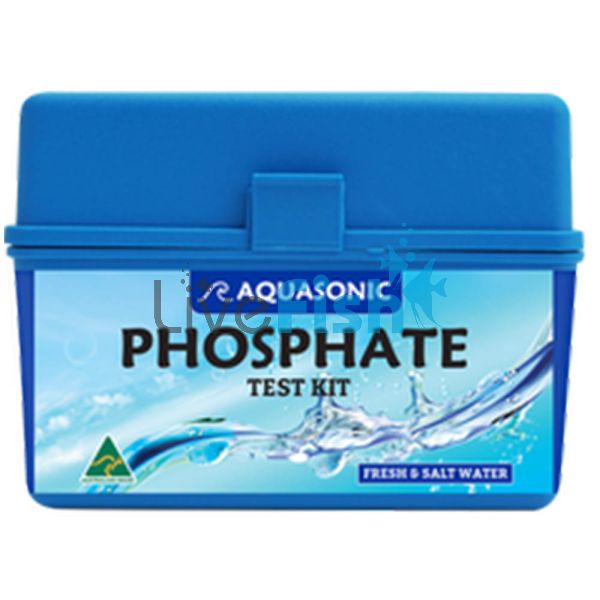Aquasonic Phosphate Test Kit
There are two types, Organic and Inorganic. The type we test for in aquaria is the Inorganic type, PO4. All living matter contains phosphorus but unfortunately, organic phosphate can only be tested in laboratories using sophisticated testing equipment.
PHOSPHATE TEST KIT
ABOUT PHOSPHATES
There are two types, Organic and Inorganic. The type we test for in aquaria is the Inorganic type, PO4. All living matter contains phosphorus but unfortunately, organic phosphate can only be tested in laboratories using sophisticated testing equipment.
THE EFFECT OF PHOSPHATES
In reef aquariums, levels of phosphates above 0.5ppm can adversely affect the growth of both hard and soft corals. It is recommended to keep phosphates at a maximum of 0.25ppm. In both fresh and saltwater aquariums, phosphates above 0.5ppm can cause the growth of hair algae, blue-green algae, and other types of algae, including green water in ponds and lakes. A side effect of phosphate in a saltwater aquarium is the precipitation of calcium. There is no evidence that levels of phosphates affect the health of fish. High levels, say above 20ppm, may affect growth.
WHERE PHOSPHATE COMES FROM
The sources can be many and varied. Some tap water contains phosphates originating from agricultural runoff or added by municipal water authorities to reduce levels of heavy metals. Some phosphates are a byproduct of fish waste or decaying algae. Some aquarium products e.g., pH adjusters, contain some phosphates. Most phosphate, however, comes from uneaten fish food due to over-feeding.
HOW TO REDUCE PHOSPHATES
The two considerations are:
- to reduce the level already present in the aquarium, use a Phosphate Sponge or similar.
- by changing some water in the aquarium. Take steps to stop the build-up in the first place. If the tap water contains phosphates, filter before use with a Phosphate Sponge or use RO water. Do not overfeed. Most important in controlling phosphates in any situation is to reduce the levels of waste or debris that may be present in the aquarium gravel or in silt behind rocks, coral, etc. Change pre-filter or mechanical filters on a weekly or more frequent basis.
HOW TO DETERMINE PHOSPHATE (AS INORGANIC ORTHOPHOSPHATE) IN SALT OR FRESHWATER:
- Rinse the clean test tube several times in the water to be tested.
- Fill the test tube to the 20ml mark with a sample to be tested.
- . Add 4 drops of Reagent A. If the solution turns red, add Reagent B dropwise until colour disappears. If there is no colour evident after adding Reagent A go to step 4.
- Add 4 drops of Reagent B and mix.
- Add 2 drops of Reagent C and mix immediately.
- Wait one minute but no longer than five minutes after the addition of Reagent C to measure the colour intensity of the sample against the colour chart. Place the test tube on the white background of the colour chart, and view it vertically with the light behind you. The colour in the test tube is best viewed with natural light.
NOTE:
- Be sure to cap all reagent bottles tightly.
- Reagent B is highly acidic and will cause skin irritation. If skin contact does occur wash immediately with cold water.
- After completion of the test, wash the test tube thoroughly as a previous test could influence the next one.
*This colour chart provides a basic guide only. Colours may vary according to various water conditions.
SAFETY DIRECTIONS
KEEP OUT OF REACH OF CHILDREN
Reagent B:
Concentrated sulphuric acid solution (5M H2SO4) containing ammonium molybdate (2.5%)
WARNING:
This substance is acidic. Avoid contact with the eyes and skin.
FIRST AID:
- If poisoning occurs, contact a doctor or Poisons Information Centre.
- If swallowed, do NOT induce vomiting. Give a glass of water and seek medical advice.
- If skin contact occurs, remove contaminated clothing and wash the skin thoroughly.
- If in eyes, hold eyes open, flush with water for at least 15 minutes, and seek medical advice
| Scientific Name | Test Kit |
|---|




